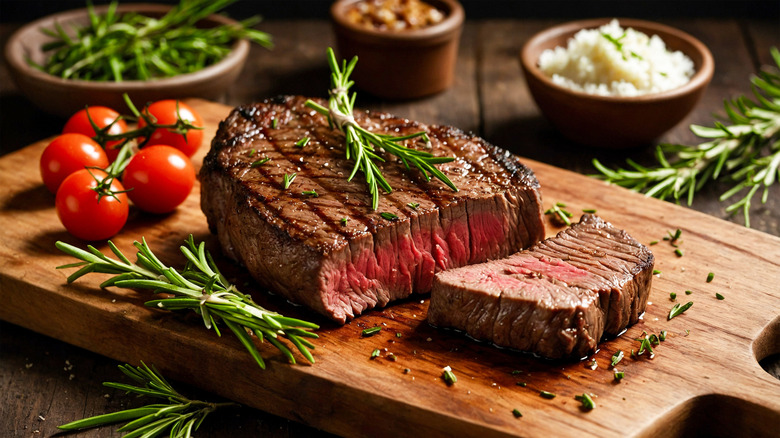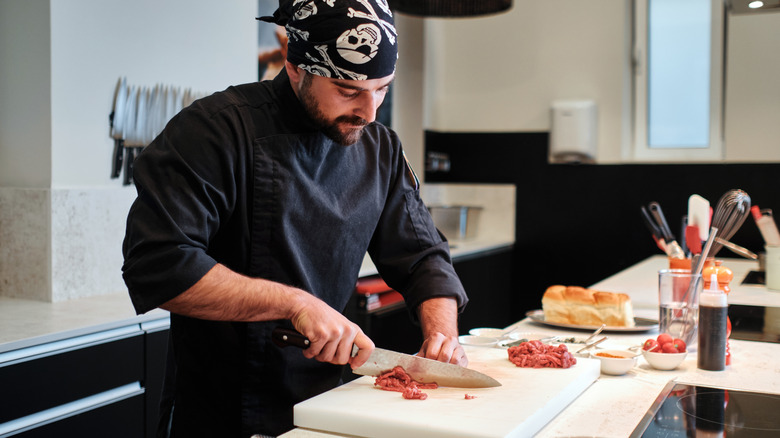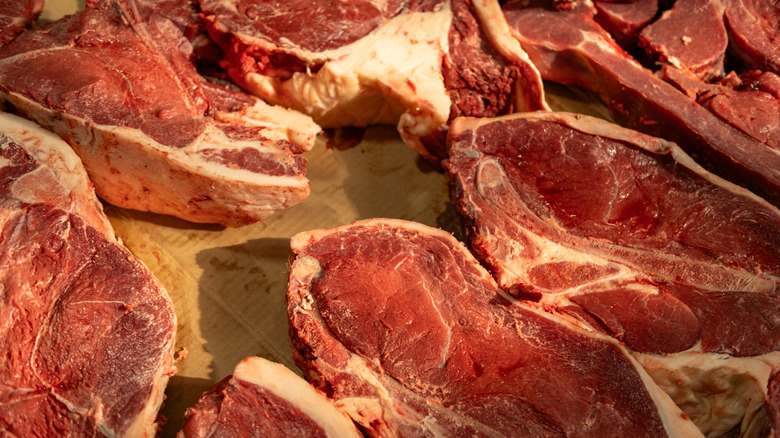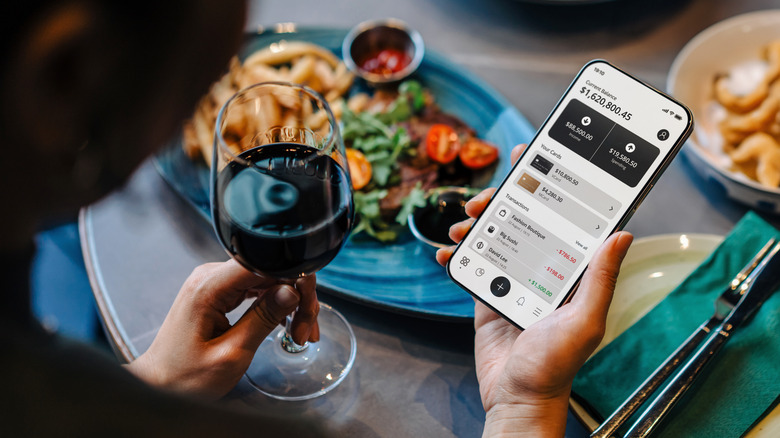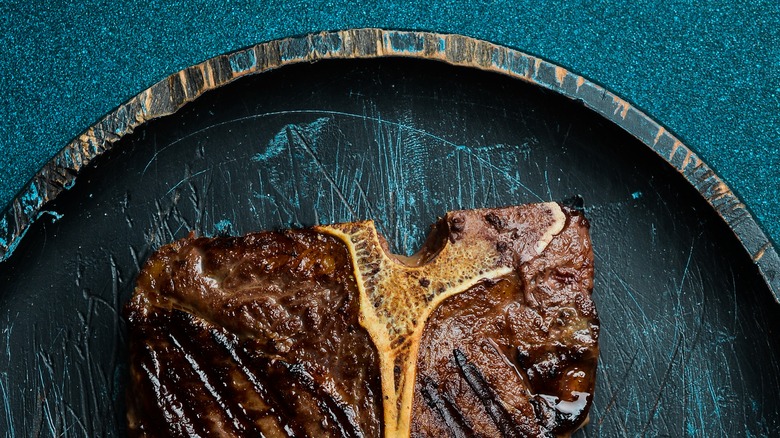15 Steak Restaurant Red Flags That Should Send You Running
We may receive a commission on purchases made from links.
Beef-forward eateries abound, and no one needs to tell you that some steak restaurant chains are better than others. "In my view, a great steakhouse strikes a balance between craftsmanship, quality, and hospitality," says Thomas Odermatt, CEO of Butcher's Bone Broth. "It starts with the meat — sourcing top-quality beef and treating it right with proper aging, seasoning, and cooking. But it's not just about the steak. The space should feel welcoming, not over-the-top. The staff should know their stuff, care about the food, and be excited to help — whether someone's a steak connoisseur or brand new to it."
Of course, there's a flip side: There are plenty of red flags to watch out for. Crummy atmosphere, ill-prepared servers, lame menus and wine options ... the list goes on, and that doesn't even include the meat itself. "You'll see a big difference between a kitchen that understands meat and one just going through the motions," says Muhammad Abdullah, a food technologist and quality assurance expert at Folio3 FoodTech. So how do you find the right steak restaurant? You can start by avoiding these 15 red flags.
A second-rate atmosphere
So, does restaurant steak really taste better? Well, maybe. One thing it for sure nails that your home-cooked steak doesn't, though, is the atmosphere. Or at least, it should. "Personally, I think a good steak restaurant makes you feel looked after, from the moment you walk into the second you take your last bite," says Nicole Hunn, founder of Gluten Free on a Shoestring. "It's not just about the beef. It's the service, the pacing, the sides, the wine, the lighting. It should feel like a little celebration, even if you're just stopping in midweek." Yet among the most common red flags at steakhouses are a lack of the above atmospheric factors.
Debra Clark, founder of Bowl Me Over, agrees. "The vibe of the place matters more than people give it credit for," she says. "If a restaurant feels dated, sterile, or weirdly empty during prime dinner hours, it can throw off the whole meal." While no one likes to feel crowded, she says, you do want a little buzz in the dining room. "You don't need white tablecloths, but you do want to feel like you're in good hands."
Uncleanliness
Dirt, grime, stickiness, or stacks of dishes are all major red flags. Nobody wants to dine in a steak restaurant — or any restaurant — that doesn't feel 100% clean and provided for. "Uncleanliness in a steakhouse or any restaurant is a dealbreaker," Nicole Hunn says. "From sticky floors to smudged wine glasses, these things signal a lack of care behind the scenes. If they're not wiping down the bar or cleaning the tables properly, what's happening in the kitchen?"
Cleanliness, Muhammad Abdullah says, is part of professionalism, and it should not be overlooked, because it's a critical factor in food safety as well. "Guests notice it, and so should owners," he says. If you walk into a steak restaurant and you see schmutz anywhere, you can feel free to leave.
Vague menus
Menus are there for a reason: to tell you what the steak restaurant has to offer and what it means for your dining experience. Vague or overly simplified menus are therefore big no-nos. "If there's no clear mention of where the beef is sourced, what cuts are available, or how the steak is cooked, that's a red flag," Nicole Hunn says. "A proper steak menu should inspire confidence and help guide diners to the right choice, not make them guess." See a menu with only one or two options? "You're probably not in for a great meal," Hunn concludes.
A good menu will also tell you exactly how they cook the steak you order. You're there for more than a hunk of meat; you want to enjoy a well-prepared dish that's probably nicer than you could make at home (which is why you're willing to pay for it in the first place). So look for preparation methods on the menu, Debra Clark says. That might mean wood-fired, reverse-seared, or another cooking method, but you should see it. "It shows confidence and helps you know what to expect. A good steakhouse doesn't just say 'We'll cook it how you want,'" she says. "They explain their process and why it works."
Limited options
A good steak restaurant should have something for everyone. That means many cuts of meat and options for those who don't want 12 ounces of beef. Look for burgers, pasta, salads, and plenty of bread to begin your meal, then check that each option is well-explained: ingredients, cooking methods, and finishes, along with dietary notations, so you can choose exactly what works for you and your party.
That's not to say the menu has to be extensive. "A clear, informative menu doesn't have to be long or fancy; it just has to help people make a confident choice," Debra Clark says. "It also tells you the kitchen knows what they're doing." Having a concise and elegant menu is totally fine as long as each diner can customize the dish to their needs. Red flags, however, include only a few dishes, nothing to serve the young or the elderly, and restricted options for how the steak gets cooked.
Servers who lack knowledge
Servers who don't know what they're talking about are walking red flags. Steak is expensive, difficult to get right, and meant to be a true experience. Servers are guides, and if they're not totally prepared to answer all of your questions about how the restaurant does business, they can handicap that experience.
"A knowledgeable server should be able to walk guests through steak cuts, doneness levels, wine pairings, and house favorites with confidence," Thomas Odermatt says. When a server can't do that, they've either been poorly trained or they're disinterested. "That's usually a sign the steakhouse doesn't take service seriously. When you're paying for a premium product, you want to feel like you're in good hands. Confident, informed servers help build trust and make the experience better all around." If servers draw blanks, give generic answers, or shrug, you might not want to eat at that restaurant, Nicole Hunn says.
"I'm not expecting a meat scientist, but if they can explain the difference between a ribeye and a filet, or suggest a wine that pairs well, it just makes the meal smoother and more enjoyable," Debra Clark adds. "I've even had servers share little tips that I've ended up using in my own recipes."
Confusingly low (or high) prices
Another reason restaurant steaks taste better is that steak joints have access to better meat. They can afford to buy all the best cuts of steak and avoid ones that aren't as appealing due to economies of scale. That's what you're paying for, so you should expect to see somewhat high costs. Price tags that are either too low or too high are, however, red flags.
"When steak prices are way too low, that's often a red flag for low-quality meat or shortcuts in sourcing and prep," Thomas Odermatt says. "On the flip side, if prices are sky-high without a clear reason, it can feel like a money grab. A good steakhouse should offer prices that make sense for the quality they serve — nothing sneaky, nothing inflated."
However, he says, the beef industry does have good reason for higher prices. "Four major U.S. meat processors control around 73-75% of the beef processing market," Odermatt says. "That kind of consolidation pushes prices up." Add high demand, the resources involved in cattle raising, fewer ranchers, and tough margins, and you've got a price pressure cooker. However, he adds, production does seem to be picking up, and steak prices should come down a bit in the next 12 to 18 months.
In the end, "Price isn't everything," Muhammad Abdullah says. "A low price may mean low quality, but a high price doesn't always mean it's good either. Pay attention to the details. That's where the truth shows up." Remember that some steaks are better for the budget than others. If you want to pay less, ask about affordable options.
No supply chain transparency
Just as you should understand how your steak is cooked and why it costs so much, you should know where it's coming from. A restaurant that doesn't detail its sourcing is throwing up red flags, and you should take heed. "If a place tells you where their beef comes from, that's a good sign," Muhammad Abdullah says. "It shows they care about sourcing and quality. Whether local or imported, it means they've made thoughtful choices." You should look for information on suppliers, the place of origin, and the aging details, Nicole Hunn says. A good steak restaurant should not only know these details — it should be proud of them.
It also shows that the steakhouse has real roots in excellence and tradition. "Sometimes even generations deep," Thomas Odermatt says. "They build strong ties with top-tier meat suppliers and rely on trusted wholesalers. In today's world, where meat supply is tight and prices are up across the board, that supply chain matters more than ever." This is especially true if you care about sustainability and ethical treatment, because some suppliers are much better at stewarding the world's resources and caring for animals than others. These are better signals of quality than words like "premium" or "choice," Odermatt says. "It adds a layer of meaning for steak lovers who appreciate the story behind the steak."
Failure to describe cooking options
Yes, there is a right way to order steak at a steakhouse. While there are a few steps to getting your meal right during ordering, you should first and foremost focus on the level of doneness you want. Whether steak restaurants undercook meat is an open question, but one thing is for sure: You can get the restaurant to cook your beef a little more, but you can't get them to de-cook it. Entropy, friends — entropy. Lack of explanation about cooking is one of the biggest red flags.
"A good steakhouse should be able to explain doneness levels and cooking techniques without making it complicated," Thomas Odermatt says. There are the basic levels of rare, medium, or well-done, with gradations in between, but it involves more than that. "Whether you like it rare or medium-well, they should help set expectations. Bonus points if they talk about stuff like dry-aging, reverse-searing, or wood-fire grilling without sounding preachy."
Want your steak Pittsburgh-style? Nicole Hunn's advice is to ask. "It's not just about giving choices; it shows the kitchen knows how to execute different techniques," she says. "If a place is willing to prepare a steak multiple ways, it usually means they've got skilled people working the grill and they've trained their team well." If you can't get what you want, though, find another steak joint to drop your hundos on.
A server who can't tell you their favorite dish
Among the worst red flags are servers who "don't know what's good here." You're the one who just walked through the door. They've presumably been here for at least a day and had time to try a steak or two, right? Free meal policies vary from restaurant to restaurant, but at the very least, employees should have tasted several dishes and be able to speak knowledgeably on them.
"A server who knows what their favorite dish is means they've tried the food and care about it," Muhammad Abdullah says. "It feels personal and genuine. It also helps you decide what to order, based on real experience." Thomas Odermatt agrees, "When a server confidently recommends something they love, that's a great sign. It shows they've tried the food and care about what they're serving." A genuine recommendation goes a long way, he adds, making you feel more connected to the restaurant, the experience, and the offering itself. Plus, Odermatt adds, "It also says a lot about the kitchen if the staff actually eats the food they're offering guests."
Poorly cooked meat
If a steak restaurant doesn't know how to cook meat well, how many more red flags do you need? "Steak needs to be cooked right," Thomas Odermatt says. "If it comes out undercooked, overcooked, or just not how it was ordered, that shows a lack of skill or attention in the kitchen. Even the best quality meat can be ruined by bad cooking." Watch out for cold meat, scorched outsides, or improperly rested meat, Muhammad Abdullah says.
"If you cut into your steak and see that it wasn't rested properly, juices pouring out all over the plate, it's frustrating," Debra Clark says. "That rest time really matters for keeping the meat juicy and letting the flavor settle in." While resting times vary, Clark lets her meat sit for 5 to 10 minutes at home to let the protein fibers relax and draw the juices back in before cutting. That's how you avoid the pool of liquid on your plate, rather than in your meat.
Cheap sides
"Low-effort sides are a red flag," Muhammad Abdullah says. "If the fries are soggy or the mash is instant, they're cutting corners. Great sides show the kitchen cares about the full plate, not just the meat."
Debra Clark agrees that cheap or boring sides are issues of which to be wary. "A plain baked potato and a side salad with bagged lettuce doesn't add anything to the experience," she says. Although sides can be simple, they must be great quality to earn their place next to a nice steak. They should be intentional, not an afterthought. "I love seeing things like roasted seasonal veg, crispy potatoes, or a really well-dressed salad with some personality," she says.
Limited dietary accommodations
Everyone in your party should be able to get what they want at a steak restaurant. Naturally, vegetarians will have to do some planning, while the gluten-free set may have to work around some additional limitations. However, if people in your party can't find meals that work for them, that means the restaurant hasn't put enough thought into serving everyone well. Red flags, enter stage right.
"A truly great steakhouse knows how to handle dietary needs with grace," Nicole Hunn says. "Whether it's gluten-free sides, low-sodium options, or dairy-free sauces, that flexibility is the mark of a kitchen that cares. Everyone should be able to enjoy a great steak, and thoughtful accommodations make all the difference." Debra Clark agrees that a good restaurant will adjust to different diets with ease. "Whether that's dairy-free sauces, vegetarian starters, or even smaller steak sizes, it's a sign that the kitchen is thoughtful," she says. Even though she loves the classic steak-and-potatoes combo, she finds the dining experience better when everyone has a shot at a great meal.
Bottled steak sauce
If you roll into a restaurant and see a bottle of A1 sitting on the table, you might want to rethink your dining choice. While A1 Original Steak Sauce is very popular online and can certainly help you take home steaks to the next level or even reinvent your basic chicken wings, it shouldn't be necessary when you're dining out. Indeed, bottled sauces of any kind are red flags.
"Bottled sauce usually means the steak lacks flavor," Muhammad Abdullah says. "A good steak should stand on its own. If sauce is offered, it should be house-made and complementary, not something off a grocery shelf." If you see sauces sitting on the table, you can ask your server about a house-made option or opt for a different flavoring of your choice, such as a pat of butter.
A lousy wine list or bar
Crummy wine bar? Uninspiring cocktail list? Short supply at the bar? These are all steak restaurant red flags that tell you to pick another eatery. It's not that hard to stock a decent wine list and bar, and to many people, they are unmissable additions to a good steak dinner. "A thoughtful wine list adds to the meal," Muhammad Abdullah says. "It shows the restaurant values pairing and wants to offer a complete dining experience. Even a small selection, if curated well, goes a long way."
Debra Clark agrees that the wine list can be concise, as long as it's good. "A well-stocked bar or a short but smart wine list also says a lot," she says. "You don't need a giant book of pairings, but a couple of really well-chosen options shows that they're thinking about the whole meal." Ideally, Nicole Hunn says, you'll want someone with whom you can discuss your drink options beyond the server, namely a sommelier. "If there's a bartender who knows how to talk spirits, even better," Hunn adds.
Bad (or nonexistent) online presence
A good steak restaurant just knows how to do it right. Their cuts are the right thickness, they have salting down to a science, their griddles and grills are always the right temperature, and they understand the importance of next-level steak toppings. A ghost-like online presence tells you that people either can't be bothered to rate them or that the restaurant can't be bothered to promote itself. And bad reviews? No explanation needed.
"If I can't find a menu, recent photos, or even clear opening hours, I'm probably not going to try the place," Debra Clark says. "A good website or active Instagram tells me they care about communication, and that usually translates to better service once I'm there."
Reviews should be pretty straightforward, because the experience for which you're looking at a steak restaurant is itself straightforward. "Start with great meat. Cook it properly. Rest it right," Muhammad Abdullah says. "Then add trained staff, smart sides, and a clean, welcoming space. If a restaurant gets these basics right every time, it doesn't need gimmicks."
